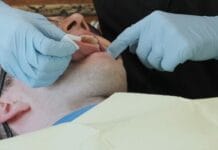Are you in need of CE credits? If so, check out our peer-reviewed, self-study CE courses here.
Test Your Oral Manifestations of Rare Diseases Knowledge
1. Oral manifestations of Marfan syndrome include a high vaulted palate, crowded teeth, TMJ dysfunction, and partial anodontia.
Marfan syndrome (MFS) is an inherited genetic disorder with an autosomal dominant pattern of transmission. Initially documented by the French pediatrician Antonin Marfan in 1896, MFS presents a spectrum of challenges across multiple organs, yet it is the cardiovascular complications that prove the most severe.
Oral manifestations of MFS include retrognathia, dolichocephaly, a high palatal vault, crowded teeth, TMJ dysfunction, and partial anodontia.
Alam, M.K., Alfawzan, A.A., Shrivastava, D., et al. Oral Health Status in Marfan Syndrome: A Systematic Review and Meta-Analysis of 353 Cases. International Journal of Environmental Research and Public Health. 2022; 19(9): 5048. https://doi.org/10.3390/ijerph19095048
2. Dental abnormalities occur in around 30% of patients with Gardner syndrome. The least common oral manifestations are osteomas of the mandible.
Gardner syndrome is a hereditary condition that causes abnormal growths in the body, including the intestines, bones, skin, and other soft tissues. Without early intervention and treatment, nearly everyone with Gardner syndrome develops colon cancer. It is considered rare, with an incidence of one in one million people in the United States.1
Dental abnormalities occur in around 30% of patients with Gardner syndrome, which may include supernumerary teeth, hypodontia, abnormal tooth morphology, compound odontomas, and impacted or unerupted teeth.2
Slow, continuously growing skeletal osteomas are an essential component of Gardner syndrome. Osteomas most frequently occur in the mandible, the skull's outer cortex, and the paranasal sinuses. Specifically, osteomas tend to occur at the angle of the mandible and are detectable radiographically. These lesions can cause facial asymmetry due to continuous growth.2
1. Gardener Syndrome. (2023, April 13). Cleveland Clinic. https://my.clevelandclinic.org/health/diseases/22013-gardner-syndrome
2. Basaran, G., Erkan, M. One of the Rarest Syndromes in Dentistry: Gardner Syndrome. European Journal of Dentistry. 2008; 2(3): 208-212. https://www.ncbi.nlm.nih.gov/pmc/articles/PMC2635905/
3. Which of the following are oral manifestations of Rett syndrome?
Rett syndrome presents as a neurological condition primarily affecting girls, with classic Rett syndrome being the most prevalent form. Typically, affected girls experience a period of seemingly normal development for six to 18 months after birth, followed by the onset of severe challenges related to language, communication, learning, coordination, and other cognitive functions.1
During early childhood, those with Rett syndrome gradually lose the ability to purposefully use their hands and often engage in repetitive hand movements like wringing, washing, or clapping. They also tend to exhibit slower growth compared to their peers, with approximately three-quarters showing signs of microcephaly, characterized by a smaller head size.1
Additionally, various other symptoms may arise, including breathing irregularities, drooling, abnormal eye movements, cold extremities, irritability, sleep disturbances, seizures, and an atypical side-to-side curvature of the spine. Oral manifestations can include an anterior open bite, high arched palate, bruxism, mouth breathing, and lip interposition.1,2
1. Rett Syndrome. (2018, October 1). MedlinePlus. https://medlineplus.gov/genetics/condition/rett-syndrome/
2. Molina-García, A., Castellanos-Cosano, L., Machuca-Portillo, G., Posada-de la Paz, M. Impact of Rare Diseases in Oral Health. Med Oral Patol Oral Cir Bucal. 2016; 21(5): e587-e594. https://doi.org/10.4317/medoral.20972
4. Dental malocclusion, high palate, mandibular micro retrognathia, enamel hypoplasia, and chronic periodontitis are oral manifestations of which of the following rare diseases?
Cri du chat syndrome results from a genetic anomaly involving the deletion of the short arm of chromosome 5. Its name, meaning "cry of the cat," stems from a distinctive clinical feature: a high-pitched, monochromatic cry reminiscent of a feline.
The manifestation, severity, and progression of the syndrome vary depending on the specific region of the chromosome affected by the deletion. While cri du chat is classified as a rare disorder, it ranks among the most prevalent chromosomal abnormalities. Its occurrence ranges from one in 15,000 to one in 50,000 live births, with a slightly higher incidence in females than males. The precise global incidence and prevalence across different ethnicities remain undetermined, as do specific risk factors associated with prenatal events or parental age.
Oral manifestations commonly observed include dental misalignment, a high palate, mandibular micro retrognathia, enamel hypoplasia, and chronic periodontitis.
Ajitkumar, A., Jamil, R.T., Mathai, J.K. (2022, October 25). Cri Du Chat Syndrome. StatPearls. https://www.ncbi.nlm.nih.gov/books/NBK482460/
5. Oral manifestations of Cowden's syndrome include multiple papules on the gingiva, labial mucosa, and tongue, giving a cobblestone appearance.
Cowden's syndrome is an uncommon autosomal dominant genodermatosis distinguished by the presence of numerous hamartomas affecting tissues derived from all three germ layers, including the skin, oral mucosa, gastrointestinal tract, bones, eyes, central nervous system, and genitourinary tract. Due to this characteristic, it was initially dubbed "multiple hamartoma syndrome."1
The majority of patients with Cowden syndrome develop a malignant neoplasm of the thyroid, endometrium, or breast.2
Orofacial features associated with Cowden's syndrome include the presence of multiple papules on the gingiva, labial mucosa, and tongue, resulting in a cobblestone-like appearance. Additionally, individuals may exhibit multiple fibroepithelial polyps, oral papillomatosis, nodular gingival hyperplasia, fissuring with lobulations on the tongue, multiple facial trichilemmomas (hamartomas of hair follicle tissue), and acral keratosis.1
1. Reddy, K.V.K., Anusha, A., Maloth, K.N., et al. Mucocutaneous Manifestations of Cowden's Syndrome. Indian Dermatology Online Journal. 2016; 7(6): 512-515. https://doi.org/10.4103/2229-5178.193911
2. Garofola, C., Jamal, Z., Gross, G.P. (2023, March 27). Cowden Disease. StatPearls. https://www.ncbi.nlm.nih.gov/books/NBK525984/
Before you leave, check out the Today’s RDH self-study CE courses. All courses are peer-reviewed and non-sponsored to focus solely on high-quality education. Click here now.












